Click to Download the PDF
Download the Word Doc
President’s Message
Welcome to the Georgina Historical Society’s June 2020 newsletter! I trust this newsletter finds you and your families well in these trying times. Unfortunately, we have to cancel our June members meeting due to the Covid 19 pandemic. I share your frustration during this unprecedented time in our lives. Unable to accomplish the usual tasks done by the GHS, let alone begin the projects we had planned to do in 2020 it seems like we are sitting “spinning our wheels” and going nowhere. Not what we had hoped for in 2020! However, for the future wellbeing of all we must conform to the Federal, Provincial and Town of Georgina guidelines and restrictions in order to conquer this pandemic.
The good news is that the plans put in place for roofing repairs, drainage survey and assessing the condition of other buildings in the Pioneer Village are being enacted. Hopefully the rebuilding of the schoolhouse will soon get underway. Melissa Matt and the new maintenance staff member for the village are back on location full time. Summer students have been interviewed and hopefully will be on board soon. If the modified Covid protocol camp does not run, the summer students will be working updating, research, exhibits, etc.
Thank you Paul Brady for your timely article on “Bonnie Park” in Jackson’s Point! Be sure to remind your councillors how important this park is to the residents of Jackson Point, Sutton and the entire Town of Georgina.
Since we are unable to have meetings to help fill our historical interests, maybe we all should do a little history sleuthing on our own during this time. Have you ever wondered about that old house, school, church, farmstead or pioneer burial ground in your area? Time to check it out! Take a picture, ask neighbours, check the internet and archives, you will be surprised what you discover. Jot down your findings; you might end up with a paragraph or a much longer story. Send us your findings; they would make a great addition to our newsletter.
Thanks. Take care, stay safe!
~ Tom Glover
Jackson’s Point Park; A Gift to the People – By Paul Brady
Now known as Bonnie Park and Lorne Park, this piece of real estate has been serving the community as the access point to Lake Simcoe for over 200 years. Its value would have also been recognized for thousands of years by the First Nations people, with its sand beach and sheltered harbour.
It had also caught the interest of a developer in recent years, as one of the last large pieces of direct lakefront on which a condominium development could be located. This possibility became a news story in early 2017 when they started drilling exploratory holes in the publicly owned park
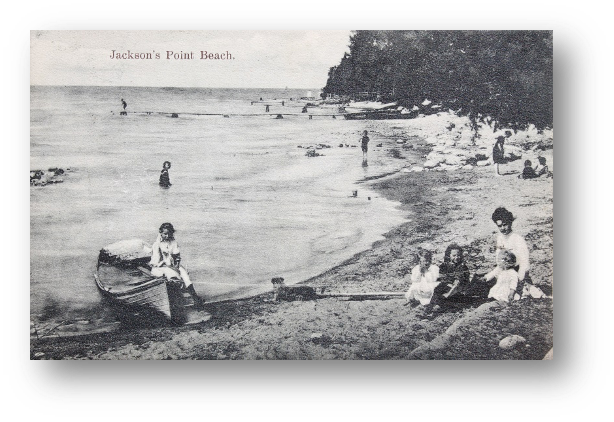
The developer had purchased the next-door property, the former Bonnie Boats Marina, in partnership with the York Regional Police for the construction of a police marine unit to service Lake Simcoe. The purchase had happened several months previously, on January 17, 2017, and the boring machine was on the park in early March2017. Understandably, the local residents were aghast at the prospect of losing the park and contact was made with the Town of Georgina to try to understand what was going on.
The Planning Partnership, a consulting company based in Toronto, was hurriedly hired by the Town to help in sorting things out. Their approach included public meetings and charettes where input from interested parties was collected and analyzed. This process was started quickly and culminated in the presentation of their findings and recommendations on June 10, 2017.
As the conclusions were unveiled, members of the public found it distressing that 4 of the 6 options offered included a condominium development on Bonnie Park/Lorne Park. This would have been accomplished by a land swap with the Town getting the remains of the former marina that the YRP didn’t need for their marine unit, and the developer getting publicly-owned park land adjacent to the Ramada Hotel.
My wife Kim, and I decided that we needed to learn as much as we could about the history of Bonnie Park/Lorne Park. About all we knew about the park at that time was that the park layout followed the roadbed of the Lake Simcoe Junction Railway, a narrow-gauge rail line later converted to standard gauge that had operated between 1877 and 1928 into Jackson’s Point. We also knew that the park had been the location of huge picnics for many years, and that Stephen Sellers had erected a dancehall on the site, at the lake-side, but that was about the extent of our knowledge.
On the following Monday, June 12, 2017,we went to the Land Registry Office in Aurora to search the title of Bonnie Park. We were pleased to learn that the title was in the name of the Town of Georgina but were surprised to find a survey dated 2014 showing that Bonnie Park/Lorne Park is one contiguous piece of land. It starts at Lake Drive East and runs right down to the high-water making a hockey stick-shaped curve, almost 3 acres in total. We had thought that Bonnie Park/Lorne Park was at least 3 pieces, with the bottom piece (this being the land in question, from the public washroom building to the lake) being a gift to the Town of Sutton from the Sellers family. It was also interesting that the survey was dated 2014. Obviously, more research was required.
When we got home, we went to the Town of Georgina web site to search the GEMS (Georgina Electronic-records Management System) for the past minutes of council, looking for clues. This is an amazing source of information. It chronicles all of the Village of Sutton town hall meetings, starting in 1908.
Between the two of us, we started in 1958 and came forward, reading every entry but not finding anything that was a direct link. Finally, in November1968, we found a delegation from a gentleman requesting to purchase a strip of this land from the town. Council responded, “As this property was deeded to the Village by the Crown as a public right of way, it could never be sold”.
This was an intriguing entry, and we were determined to understand what it meant. We felt that this must be tied to a note on the survey that stated “unregistered deed dated 22 December 1937 George the 6th to The Village of Sutton. “So, we went back to the GEMS and started going through every entry, starting in 1937. We found no relevant entry until early 1938, with an entry stating “{….} certain lands known as CNR right of way and consisting of two and eighty-two hundredths acres more or less have been granted to the Village of Sutton.
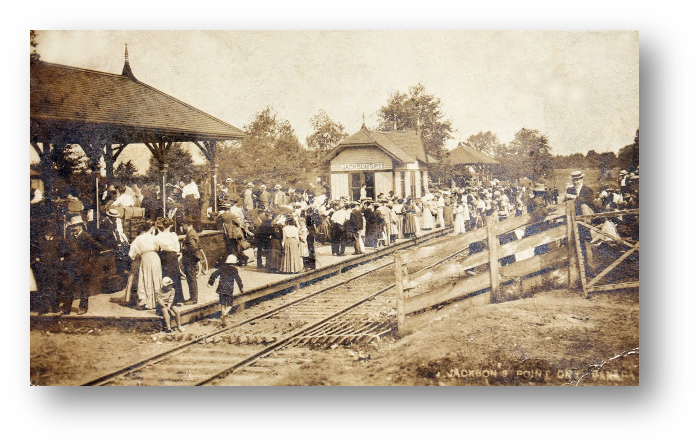
Therefore, be it resolved that this municipality accept this Grant and agree to maintain the Right of Way as a Public Right of Way at the expense of the Municipality. The Municipality also agrees to be bound by any stipulations contained in the aforesaid Instrument dated at Ottawa on December 22, 1937.” This was accepted into the town records in early 1938.
This entry was enlightening, and we were determined to learn more. We started with Town of Georgina staff, and spoke to several departments, including doing a freedom of information request. No more information was forthcoming, and we finally came to the conclusion that the records must have been lost in a paper drive during the Second World War, or perhaps a fire that had occurred. This was a dead end, and we still had several questions. We decided to try to understand the chain of events leading up to the construction of the Edgewater dance hall in 1934. Contacting Melissa Matt, the curator at the Georgina Pioneer Village and Archives, we learned that the Lake Simcoe Junction Railway, established about 1877, had been taken over by the Grand Trunk Railway, which was then absorbed by the Canadian National Railway, at that time a Canadian Crown Corporation. When the rail line was closed to Jackson’s Point in 1928, the rails were removed and Bonnie Park/Lorne Park would have been vacant land, owned by the Crown.
Right of way with removed rails curving towards the pier. The Edgewater Pavilion can be seen by the water.
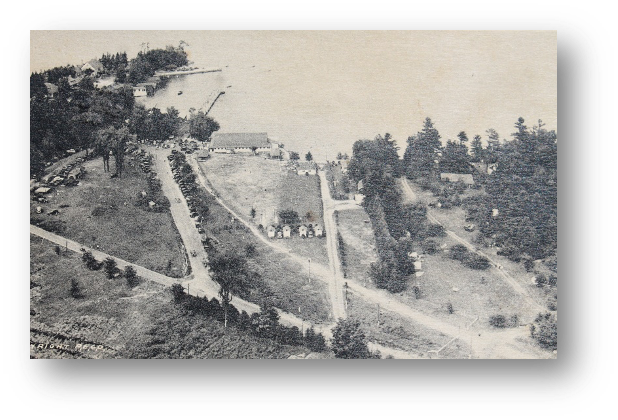
We then spoke to members of the Sellers family who told us that Stephen Sellers had owned the adjacent property, what we now recognize as the Ramada hotel property. We learned that he sub-leased the Bonnie Park/Lorne Park land from the Village of Sutton, which was leasing it from the Crown. Mr. Sellers operated a campground and tourist cabin business on his own property, and had built the dance hall on the Crown land to augment this business. Mr. Sellers must have felt that he had a solid lease agreement, as the Edgewater Dance Pavilion would have been a substantial investment in those depression-era years.
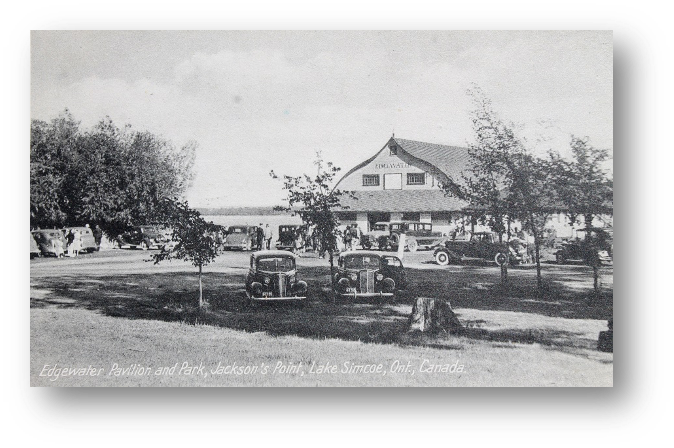
Edgewater Pavilion and park
Our next step in gathering information put us in touch with “The Library and Archives Canada.” On June 29, 2017 we sent an email to them explaining what we knew to date. We got a reply on August 9 that stated: “Thank you for your request concerning the conditions under which a CNR right of way was transferred to the Village of Sutton, Township of Georgina, York County, Ontario. I am pleased to report that I found two documents in our collection in which the conditions are indicated. They are as follows:”
“{…} on the condition that the said right of way be declared a public right of way and be maintained as such at the expense of the Grantee.”
The email went on to state that this quote was from the letter patent issued to the Village of Sutton on 22 December 1937. It also told us that this document had been digitized and its content is available on line, and advised that the other document is an Order-in-Council approved on the same date. Unfortunately, that document wasn’t available online, but that they would find it and forward a copy to us if we were willing to purchase reproductions. We ordered the reproductions, and several weeks later we received a document stating:
George the Sixth, by the Grace of God of Great Britain, Ireland and the British Dominions beyond the Seas, King, Defender of the Faith, Emperor of India. TO ALL WHOM these presents shall come,
GREETING:-
WHEREAS the right of way over the lands hereinafter described is vested in Us the right of Our Dominion of Canada.
AND WHEREAS Our Governor General in Council did, by order bearing date the twenty-second day of December, in the year of Our Lord One thousand nine hundred and thirty-seven, direct that the said right of way be transferred to the MUNICIPALITY OF THE VILLAGE OF SUTTON, in the Province of Ontario, hereinafter called the Grantee, on the condition that the said right of way be declared a public right of way and be maintained as such at the expense of the Grantee.
It went on to describe Bonnie Park/Lorne Park exactly as they are today, then wrapped up to say {….} TO HAVE AND TO HOLD the said right of way over the said lands unto the Grantee, its successors and assigns, forever.
Given under the Great Seal of Canada;
WITNESS: FREDERICK LINWOOD CLINTON PEREIRA, Esquire, Officer of Our Most Excellent Order of The British Empire, Deputy of our Right Trusty and Well beloved John, Baron Tweedsmuir of Elsfield, a Member of Our Most Honourable Privy Council, Knight Grand Cross of Our Most Distinguished Order of Saint Michael and Saint George, Memberof Our Order of The Companions of Honour, Governor General and Commander in Chief of Our Dominion of Canada.
At Ottawa, this Twenty-second day of December, in the year of Our Lord, One Thousand nine hundred and thirty-seven and in the Second year of our Reign.
BY COMMAND,
W.P.J. O’Meara
Acting Under Secretary of State
J.B. Hunter
Deputy Minister of Public Works
We did a search on all of these gentlemen and came away very impressed. We still didn’t know why the Crown granted the land to the Village of Sutton. It would have made sense to sell the property to Stephen Sellers, considering his considerable investment in the dancehall. Perhaps the Crown recognized, even over 80 years ago, the value of direct lakefront property to people not privileged enough to have their own. They certainly were clear as to what their intentions were.
By now we had the early history pretty well figured out. Our thoughts now turned to questions about the 2014 survey. Why was it commissioned, and for what purpose? Then we thought back to the original notation on the survey map that said “unregistered deed dated December 22, 1937George the 6thto the Village of Sutton”. Could it be that the Town had never acted on the Crown Grant, and didn’t complete the paperwork to actually put the park into its possession? I took another trip to the Land Registry Office and searched title again, now that I knew what I was looking for.
Sure enough, that appears to be what was going on. As we thought about how this oversight had been discovered by the Town, we remembered a rental deal that the Town had been negotiating with the York Regional Police. Back in 2013, the YRP was interested in establishing a marine unit in Jackson’s Point. The building was to be placed on the beach at Bonnie Park and it appears that as the paperwork was being sorted, the oversight was discovered and rectified, complete with a new survey.
As we now know, that deal fell through and the YRP ended up establishing themselves at the end of the channel, next to Lorne Street, preserving the sand beach and public lake access that Bonnie Park/Lorne Park affords.
Bonnie Park/Lorne Park is still intact in its original configuration. It was recognized as a significant historical site in 2017 when it was listed on the Georgina Heritage Property list. A Heritage Designation for the park is still being pursued.
Roches Point – By Terry Carter
Roches Point, the little village near the top of Cook’s Bay, is another of our history’s almost happeneds.
It was almost chosen to be the capital of the colony of Upper Canada, replacing Toronto (then called York), but almost only count as footnotes to history.
Sir Peregrine Maitland, the colonial lieutenant governor who took office in 1818, felt his little capital on Lake Ontario was far too vulnerable to attack from the rambunctious and sometimes hostile republic to the south. Few would have argued with him, for York’s capture and sack by American troops in 1813 was still fresh in everybody’s mind.
Good military man that he was, the governor began looking for townsites that were easy to get to but protected from American waters.
Lake Simcoe then was part of the colony’s major transportation corridor in an era when water travel was much preferable to going by land. Roches Point had easy access by steamer from Yonge St.’s terminal at Holland Landing and Maitland could foresee the day when the Trent and Rideau waterways would be developed and it would be a port on the main commercial and military routes of the province.
Highways and railroads changed all that within half a century, and eventually the government sold off the land it had bought for a new capital on Lake Simcoe.
In the 1860s a former British naval officer, Capt. May, operated a steamship line from the village and today his magnificent Victorian Gothic home, Lakehurst, remains one of the area’s landmarks. But May was not the first owner of the land at the point. Calvin Eames bought the land from Quaker colonizer Timothy Rogers in 1804, and therein lies a strange and tragic story. Eames fought for six years in the Revolutionary army in the U.S. war of independence, but then in 1802 left the republic he had fought to found and emigrated to Upper Canada. He spent the next decade clearing and working his isolated farm and seemed well on his way to prosperity in 1812 when tragedy struck.
Calvin was heading across Cook Bay with a load of grain, probably on his way to the mill at Holland Landing, when his boat capsized. He was drowned, along with his son, daughter-in-law, son-in-law, grandson, and an Indian guide. His wife and two surviving sons continued to live in the two-storey house he had built. Still on the property today is a fieldstone cabin once used by the Eames as a trading post where they bartered with the Natives.
Close to Lakehurst stands another beautiful Roches Point home with a fascinating story, Beechcroft. A mansion by any standard, this home was built in 1870 by Anson G.P. Dodge, an American lumberman with an aura of intrigue and mystery about him.
Dodge belonged to a prominent U.S. lumbering family and at one time he maintained homes in New York and Georgia. What isn’t known is why he chose to exile himself to rural Ontario, cutting himself off from contact with his family. When he moved to Beechcroft he left his wife and son in the U.S. whom he never again contacted. He was by no means without resources. Anson Dodge became president of the Georgian Bay Lumber Co. and vice-president of the Toronto, Simcoe and Muskoka Junction Railway.
Today, Roches Point shows few vestiges of its promise of prominence in former years. A tiny village with a fascinating past, it seems likely to stay that way.
Deer Park Public School – By Bob Holden
This became my first school after graduating from Toronto Teacher’s College in 1973. Located in the North end of Keswick near the shores of Lake Simcoe on the southeast corner of Varney and Deer Park roads, there has been a school on the site since 1882. Prior to that, a school is shown on the south side of Deer Park Road just west of Varney Road in the York County Historical Atlas of 1878.
In 1969 the small school boards of York County amalgamated to create the York County Board of Education. At this time many of the old one and two room schools were closed and sold. One of them was moved into our Pioneer Village. Students were relocated to larger schools with more up to date facilities. Only a small number of these one-room schools remain within the fabric of our present day school buildings in York Region and Deer Park Public School is one of them.
The first school on site of present day Deer Park Public School was built in 1882 and came to be known as Lakeview School, school section #6, North Gwillimbury. It was a frame building that was kept heated by a wood stove in the winter. In 1912, the school board built a new one-room schoolhouse that cost a little over $4000. This brick structure remains part of Deer Park school today.
In the next 10 years many improvements were made including the acquisition of a piano, flagpole and a school garden. In 1930, an addition to the school for junior classes was constructed. In 1953 the school expanded yet again with a third classroom being added in the basement. A second addition was added to the school in 1954, which sustained a growing population until 1969 when a much needed wing was added to Deer Park.
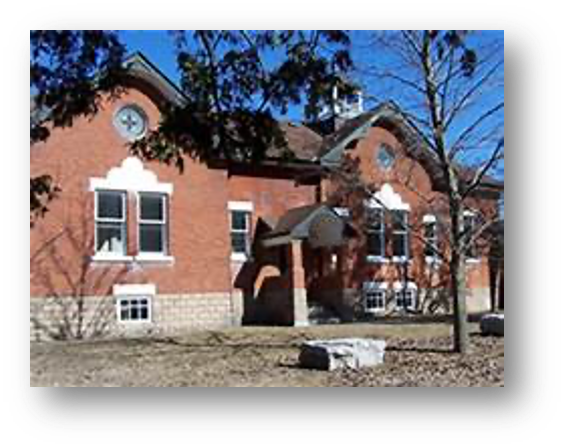
The school continued to grow in the 1970’s and 1980’s. The school received a gymnasium and a library in 1972 and several portable classrooms in 1985. I arrived shortly after the gym and library were added. At that time Deer Park served students from kindergarten to grade seven. George Easy was the Principal. Today under the leadership of Principal Catherine Robinson Buyukozer, the school continues to serve the community north and east of Keswick from kindergarten through grade eight having an enrolment of 190 students.
Where in Georgina?
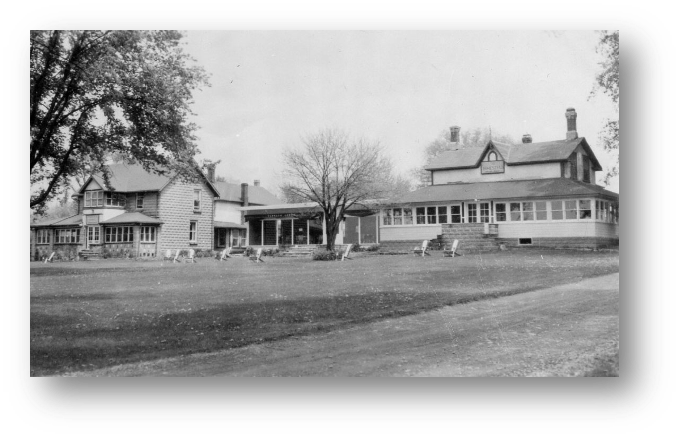
Dee Lawrence correctly identified the last mystery picture as 831 – 835 Lake Drive in Jackson’s Point. Bill MacEachern and his wife used to live in the home in the foreground, and they rented out the 3 connecting “townhomes” in the background which were part of their property. Dee lived with her husband and family in the one on the end when they first arrived in Georgina and began to teach at Sutton P.S. Can you identify our new mystery picture above?
News and Events
There is potential for calling virtual meetings using ZOOM that needs to be explored. Your executive will examine this and advise the Board and the membership if this is a tool we may use in this manner. This would allow us to discuss concerns and issues without meeting face to face. In the meantime, any and all important news and concerns will be forwarded to the membership via e–mail bulletins to ensure everyone is kept up to date and informed.
The following web link puts Don Mclean’s song “American Pie” into an historical context. Much of our membership lived through and witnessed the events depicted in the video. It gives new meaning to the song. American Pie was the name of the airplane that crashed and carried Buddy Holly, Richie Valens, and the Big Bopper to their deaths. Click on the link and enjoy!
Upcoming Events
July 1st – Canada Day will be a virtual celebration this year.
Most other events are on hold for the moment pending decisions by our various levels of government on how we will be opening up and under what conditions we may gather in larger groups. Due the pandemic restrictions and precautions at this time it is uncertain whether we will be able to hold Harvest Day this September. An e-mail bulletin will be forwarded to the membership as soon as we have any information.
